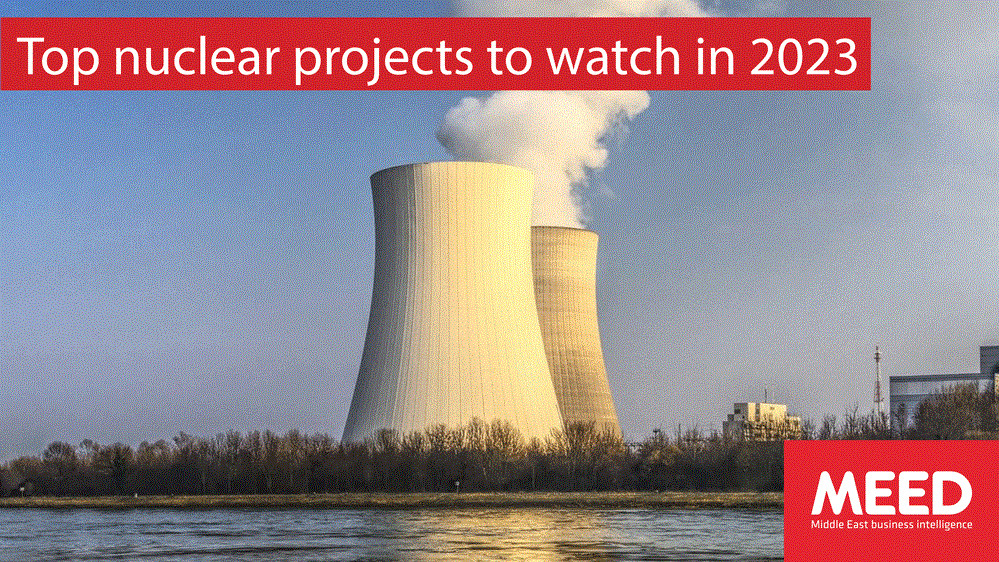

Nuclear power plant projects are gaining traction globally as well as in the region, offering clean, albeit expensive, baseload for electricity systems during the energy transition, replacing liquid fuel and gas or coal as feedstock.
Iran and the UAE are the first countries in the Middle East & North Africa region to have generated electricity from nuclear power plants. But others are quickly following suit.
| 1. Saudi Arabia |
In September 2016, MEED reported that Saudi Arabia was carrying out technical and economic feasibility studies for the kingdom’s first nuclear project, a 2.8GW facility.
Riyadh plans to develop nuclear power through a three-pronged strategy. The majority of the nuclear power capacity will be developed through conventional, large-scale nuclear facilities, such as the one that was studied in 2016 by major consultants.
RELATED READ: Riyadh moves forward with nuclear power plans
The kingdom also plans to develop atomic energy through a series of smaller, system-integrated modular advanced reactor technology (Smart) nuclear power plants in partnership with South Korea. The third pillar of Saudi Arabia’s nuclear energy programme will involve mining uranium resources to fuel the plants.
US firm Westinghouse, France’s EDF, Russia’s Rosatom, South Korea’s Kepco and the China National Nuclear Corporation are understood to have expressed an interest in building the kingdom’s first large-scale nuclear project in the past, although sources say the number of prospective bidders may be down to two or three companies.
| 2. Barakah phase 2, UAE |
Three of the four 1,400MW nuclear reactor units at Abu Dhabi’s Barakah nuclear power plant are now operational. Plans for the next phase, which will comprise another four units, are understood to remain viable and could start to be procured soon, according to industry sources.
The UAE’s aim to reach net-zero carbon dioxide emissions by 2050 as well as to export clean energy through the GCC grid could fuel its nuclear ambitions, not to mention its interest to invest in and operate nuclear power plants abroad.
RELATED READ: Nuclear power investment potential grows
Its recent nuclear cooperation agreements with South Korean firms as part of a $30bn investment deal with the East Asian nation provide evidence of Abu Dhabi’s intention to be a global nuclear power partner and supplier. This strategy is in line with the country's goal to expand its global energy portfolio currently dominated by oil exports, and which, in the future could include low-carbon ammonia and hydrogen as well.
| 3. El-Debaa, Egypt |
The first reactor at Egypt’s $29bn El-Debaa nuclear power plant is scheduled to be operational in 2026. The facility, to be located in the Matrouh province on Egypt's Mediterranean coast, will have four units, each with a capacity to generate 1,200MW.
Russia’s State Atomic Energy Corporation (Rosatom) is the project’s main contractor. State-owned South Korea Hydro & Nuclear Power (KHNP), a subsidiary of Korea Electric Power Corporation (Kepco), will construct the main and auxiliary buildings and structures of the turbine islands for the nuclear units between 2023-29 for $2.2bn.
It subcontracted Doosan Enerbility for 82 buildings and structures, covering the turbine building, water treatment and air conditioning systems as well as the installation of the turbines and generators. This contract is valued at $1.2bn.
In July 2021, Egypt’s Nuclear Power Plants Authority (NPPA) said there are plans for Egypt to build more nuclear power plants to support the country's development goals.
| 4. Karun, Iran |
In December, Iran began the construction of a new nuclear plant in the southwestern province of Khuzestan. The 300MW Karun power plant is located in the Darkhovin district of Khuzestan. Construction of the plant will take seven years and is expected to cost between $1.5bn and $2bn.
Before this, Atomic Energy Organisation of Iran (AEOI) head Mohammad Eslami said the Islamic Republic plans to invest 50bn $50bn in building new nuclear power plants to generate 10,000MW of electricity
Iran operates a nuclear power plant in Bushehr, which produces 1,000MW of power. Rosatom commissioned the single-reactor nuclear plant, which was estimated to have cost Iran between $8.5bn and $11bn, between 2011 and 2013.
There are plans to expand the Bushehr plant, with AEOI confirming in January 2022 that negotiations were under way between Tehran and Moscow to construct two additional units at the nuclear power facility.
| 5. Morocco |
Morocco’s Energy Transition and Sustainable Development Ministry conducted a study in 2015 on the construction of nuclear power plant reactors in line to expand the role of clean and renewable sources in Morocco’s overall electricity production mix.
The results of that study were to be presented last year to the country’s parliament. The report comprises recommendations for switching to nuclear energy, according to Energy Transition and Sustainable Development Minister Leila Benali. The recommendations include the framework and infrastructure as well as legislation for nuclear energy projects in the North African country.
| 6. Jordan |
The kingdom was considering building a 1,000MW nuclear power plant by 2025. This plan has changed with Jordan currently considering the deployment of small modular reactors (SMR). In 2019, the Jordan Atomic Energy Commission signed a memorandum of understanding with US-based NuScale Power to undertake a feasibility study looking into the deployment of NuScale Power’s SMR technology.
The country has significant uranium resources, with Jordan Uranium Mining Company announcing the production of 20 kilograms of yellowcake from 160 tonnes of uranium ore at a newly operational processing facility in May 2022.
You might also like...

Cyberattacks impact 44% of UAE retailers
24 April 2024

Abu Dhabi and Oman launch $180m tech fund
24 April 2024

Oman LNG wins key supply deals
24 April 2024

UAE and Oman firms sign $32bn energy deal
24 April 2024
A MEED Subscription...
Subscribe or upgrade your current MEED.com package to support your strategic planning with the MENA region’s best source of business information. Proceed to our online shop below to find out more about the features in each package.








